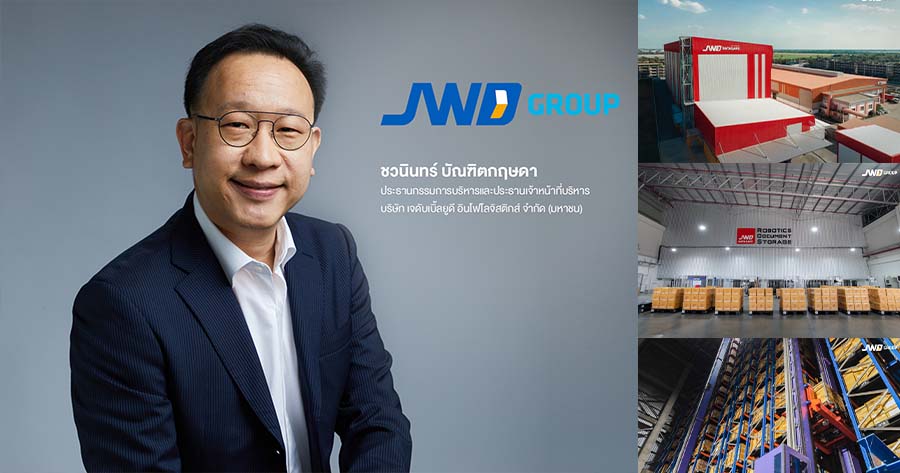JWD InfoLogistics Public Company Limited (SET: JWD) is stepping up as leader of warehouse robotics following a sustained expansion program. In the card for the latter half of this year is a plan to open three new warehouses for robotic cold storage, coming after opening Thailand’s first robotic DataSafe warehouse for storing documents. The plans aim to boost storage capacities, enhance speed and accuracy, reduce use of electricity, and mitigate labor shortages. AI and a variety of innovative technologies are in the pipeline to pave the way as the Smart Warehouse provider.
Charvanin Bundikitsada, Chairman of the Executive Committee and Chief Executive Officer of JWD Pcl. (JWD), ASEAN’s recognized expert in logistics and supply chain, says JWD is determined to uplift its warehousing business to become the “leading robotic warehousing operator”. The company has begun to introduce robotic technologies at its cold storage in Samut Sakhon since 2019 to increase warehousing capabilities, deal with labor shortage issues, increase speed, accuracy and safety, and reduce power usage. Since then, the technologies have expanded to encompass both cold storage operations and DataSafe documents warehousing under the JWD Group of companies.
JWD currently operates robotic cold storage in three warehouses covering a total area of 21,000 square meters, equivalent to 46,000 pallets. Three more buildings in Saraburi, Samut Sakhon and Bang Na area are expected to come online in the third and fourth quarters of this year, providing a total area of 17,000 sq m or 40,000 pallets, pushing the grand total to 38,000 sq m of area or 86,000 pallets. Additionally, a robotic warehouse for document storage in Suwinthawong area of Chachoengsao province covering an area of 5,000 sq m or about 745,000 boxes has opened for business. JWD is the first company in Thailand to provide robotic document storage warehousing.
“If we consider the size of service area for storing goods, it’s fair to say that JWD is the leading provider of robotic warehousing services,” says Mr. Charvanin. “We want to increase our storage capabilities, address labor shortage issues, and reduce accidents involving forklifts. That’s why we brought in computer-controlled robotic technologies, which have been designed and jointly developed with supply chain operators, to provide superior storage capabilities compared to traditional warehouses and better serve customers.”
The JWD executive committee chairman and CEO adds that robotic warehousing employs the Automated Storage and Retrieval System (ASRS). It moves goods automatically on tracks to deliver them to cranes which then place them on shelves. The system has several advantages, including: (1) ability to store goods on shelves up to 16 stories high, doubling the original capacity of 5-7 stories, leading to cost saving in terms of land and ability to operate in storage with temperature as low as minus-20 degrees Celsius for an extended length of time without limitations compared to using manual labor, and to use sensors-guided system that makes lighting redundant; (2) ability to store and retrieve goods with speed and accuracy at less than three minutes per rack or pallet compared to 10 minutes in the past when using a mobile pallet system and up to 30 minutes for shelving; (3) less dependence on manual labor resulting in reduction of workers from 5-15 per warehouse to one or two because forklift operators are no longer needed; (4) reduced energy use because no forklifts are needed and less lighting is required.
The company plans to continue developing warehouse robotics to produce Smart Warehouses by adopting artificial intelligence (AI) and other innovative technologies for various processes in addition to goods storage. Currently, AI has been linked to closed circuit cameras to monitor sea food products on conveyor belts for sorting fish species to replace human labor. JWD has developed its own camera system to be connected to the activity and has applied for a petty patent from the Department of Intellectual Property while at the same time introducing a chat bot system as a tool for employee training, keeping track of new employees and to be further developed to build on the information system.
In addition, robotics has been applied to various other operational processes within the cold storage warehouses, for example, laying out products on trolleys before delivering them into freezers with temperature of minus-40 degrees Celsius. The technology is also used at the cold storage in Bang Na, which offers complete fulfillment services including storage, packaging and delivery, and is scheduled for opening in the fourth quarter of this year. The facility spans across 2,000 sq m, making it possible to rendering services that will make a difference from other operators.
Boosting service efficiency and reducing costs aside, JWD also adopts technologies that promote environmental and social sustainability. The company has installed solar panels on warehouse rooftops and wastewater treatment systems at its facilities, and introduced electric forklifts in its warehouses. It also is committed to promoting the concept of green logistics by developing seamless transportation across land, rail and sea.





